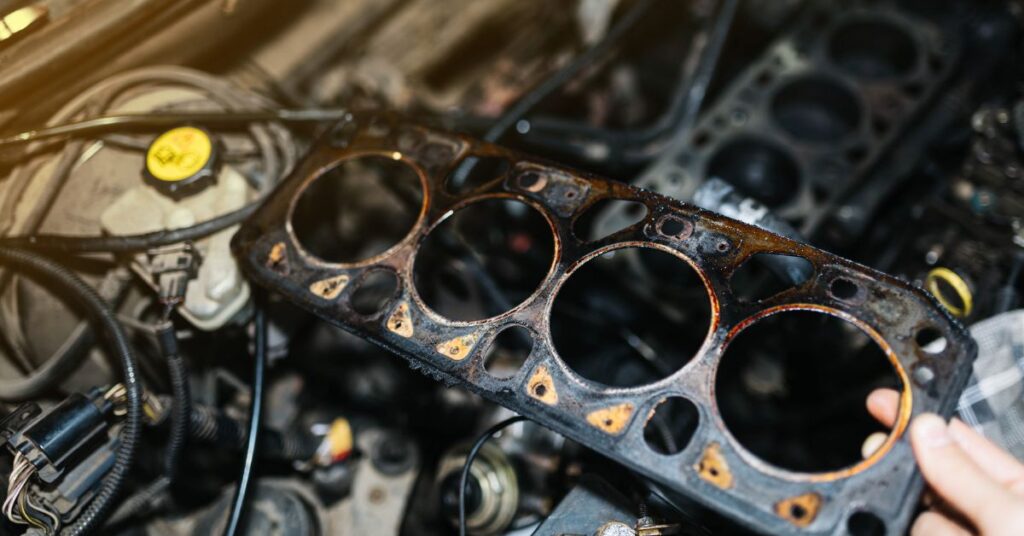
Table of Contents
The head gasket is essential to your vehicle’s engine performance. It acts as a seal between the engine block and cylinder head, ensuring that liquids and gases, like air-fuel mixture, engine coolant, and oil, don’t mix. By staying separated, these liquids and gases can perform their designated functions effectively. This article will explain more about the head gasket’s role in a vehicle and how to determine if you have a blown head gasket on your hands.
What Does The Head Gasket Do?
The head gasket is designed to withstand high pressures, up to 700 psi in gasoline engines and 2,000 psi in diesel engines. It works to keep the combustion pressure regulated within the chamber. It also prevents coolant and oil from entering the cylinders, ensuring that each liquid performs its function without interference. Without a functioning head gasket, coolant, oil, and other essential liquids could mix, rendering them ineffective at their respective duties.
How To Tell If You Have a Blown Head Gasket
Detecting a blown head gasket early can save significant repair costs and time. Here are eight common signs you might have a blown head gasket, ranging from slightly concerning to severely concerning.
External Oil or Coolant Leak
This sign is often noticeable at the seam between the engine block and the cylinder head. The presence of unexplained oil or coolant leaks in this area can strongly indicate a failed head gasket or possibly a crack in the engine block itself. These leaks can lead to reduced engine efficiency and potentially severe engine damage if not addressed promptly.
Look at the ground after your car has been parked for some time. Use this guide to help determine what the leak is by its color and smell.
Cylinder Misfire
An engine misfire, particularly between two adjacent cylinders, often points to a breach in the head gasket. This can disrupt the engine’s firing order and lead to uneven engine running, reduced power, and increased emissions. It’s a clear sign that the integrity of the combustion chamber has been compromised, which can result from a blown head gasket.
Startup Misfire with White Exhaust
If your vehicle misfires during startup accompanied by white exhaust smoke, it could indicate coolant leaking into the combustion chamber. This usually occurs when the head gasket fails, allowing coolant to seep into the cylinders. Allowing this to continue could lead to inefficient combustion and potential engine damage.
Engine Overheating
One less obvious but serious sign of a blown head gasket is engine overheating. This can manifest as unusual temperature spikes, often accompanied by bubbles or steam in the coolant overflow tank. This suggests that exhaust gases leak into the cooling system through a breach in the head gasket, disrupting the engine’s ability to maintain its correct operating temperature.
Blue Exhaust Smoke
Another possible sign of a blown head gasket is blue smoke from the exhaust, indicating oil burning in the combustion chamber. While other issues like worn engine components can also cause this symptom, it’s particularly concerning when combined with other symptoms of head gasket failure.
Discolored Fluids
Unusual discoloration in your vehicle’s fluids, such as oil or coolant, is a more subtle sign of a head gasket issue. This discoloration often results from cross-contamination between oil and coolant passages, indicating a breach in the head gasket.
Coolant-Contaminated Oil
When the head gasket fails, coolant can mix with oil, leading to a frothy, latte-like consistency in the oil. This mixture is typically visible under the oil cap or in the valve covers, and it can cause significant engine damage if not addressed.
Oil-Contaminated Coolant
Similarly, a failing head gasket can allow oil to leak into the coolant system. This contamination often appears as a mayonnaise-like film in the coolant, visible on the radiator cap or overflow reservoir. This affects engine cooling efficiency and can lead to more extensive engine problems.
Contact McCullough NAPA For Head Gasket Repair or Replacement
If you notice any of these signs, it’s important to address the issue promptly. McCullough NAPA Auto Care specializes in diagnosing and repairing head gasket issues. Contact us for a comprehensive inspection and necessary repairs or replacements to ensure your vehicle’s optimal performance and longevity. Don’t let a blown head gasket disrupt your driving experience – we’re here to help.

